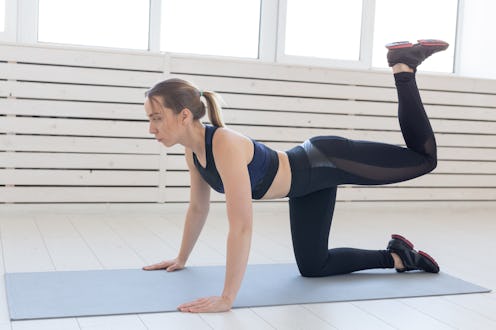Fitness
Why Donkey Kicks Are The Ultimate Butt-Sculpting Move
Here's how to do them in perfect form.

The donkey kick is one of those aptly-named exercises — like the bear crawl or crab walk — that looks exactly how you’d expect it to. So yes, it involves getting on all fours and kicking your leg back like a donkey. To get the most out of the butt-sculpting move, though, you don’t want to kick willy-nilly — you’ve got to do it in proper form.
The donkey kick exercise ranks right up there with squats and lunges as one of the best ways to target your glutes, says Gwen Dannenbaum, an ACE-certified personal trainer and director of programming at KickHouse. “With the proper technique, the donkey kick is a highly effective isolation exercise for the gluteus maximus and gluteus medius,” she tells Bustle. This is thanks to the hip-hinging motion of the kick, which totally zeroes in on your butt.
Also called a glute kickback or quadruped kickback, the move is a good one for improving hip mobility, especially if you sit all day, says Ryan Kennedy, a NASM-certified trainer and fitness director at The Park. “The donkey kick exercise targets the larger glute muscles while also lengthening the hip flexors, the muscle group that gets tight when you sit for prolonged periods of time,” he tells Bustle. “Performing this exercise correctly can adjust the pelvis and promote good posture, often decreasing incidents of pain in the lower back.”
Because you do a donkey kick while balancing on all fours, it also gives your arms and abs a workout. “The main movement is executed by bracing at the core and lifting one foot toward the ceiling,” Kennedy says, so to stay balanced in the proper position, the muscle groups holding you up are firing. And as an added bonus? The kick can be easily modified to match any fitness level, says Dannenbaum. Here’s everything to know about the donkey kick exercise and how to do it correctly.
How To Do The Donkey Kick Exercise
Here, Dannenbaum explains how to do a traditional donkey kick using good form.
- Set up in the starting position on all fours.
- Make sure your knees are hip-width apart, your hands are under your shoulders, and your neck and spine are neutral.
- Brace your core.
- Lift your right leg.
- Keep your knee bent and your foot flat.
- Use your glutes to hinge at the hip and press the sole of your foot directly up toward the ceiling.
- Squeeze your butt muscles as you pause and hold for a second.
- Check that your pelvis and working hip are square with the floor.
- Lower your knee and return your leg to the start.
- Aim for 4 to 5 sets of 20 reps per leg.
How To Modify The Donkey Kick
To make this move a little easier, Dannenbaum suggests dropping down onto your forearms to create a more stable base. This modification allows you to feel less pressure in your arms or core, and you can focus all your attention on your glutes.
To make the move more challenging, add some resistance. Kennedy recommends looping a resistance band around your foot or above your knees. “You can also secure a dumbbell in the crux of your knee to add weight when lifting the leg,” he says. For even more burn, throw in a longer hold or a pulse at the top of the movement, Dannenbaum says.
Form Mistakes To Avoid
Keep an eye on your back as you do donkey kicks. “The most common mistake when performing this move is excessive movement of the spine,” Kennedy says. “Many people will try moving through too much range of motion. The movement should be small and focused.”
If you feel yourself wiggling or if you experience back pain after giving it a try, Kennedy says that’s a sign you were moving too much. To stay steady, Dannenbaum suggests keeping your hips square and your core engaged. That should do the trick as you kick your way to stronger glutes.
Studies referenced:
Neto, WK. (2020). Gluteus Maximus Activation during Common Strength and Hypertrophy Exercises: A Systematic Review. J Sports Sci Med. PMID: 32132843; PMCID: PMC7039033.
Sources:
Gwen Dannenbaum, ACE-certified personal trainer, director of programming at KickHouse
Ryan Kennedy, NASM-certified trainer, fitness director at The Park
This article was originally published on